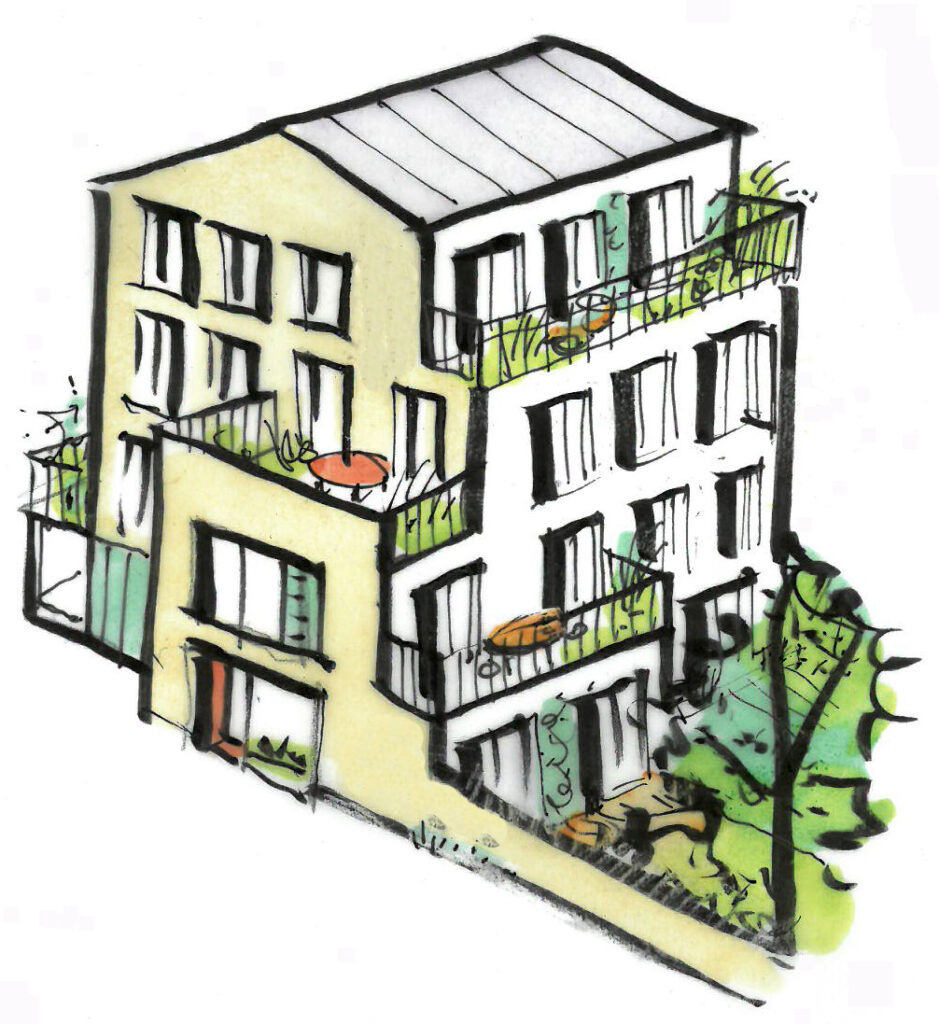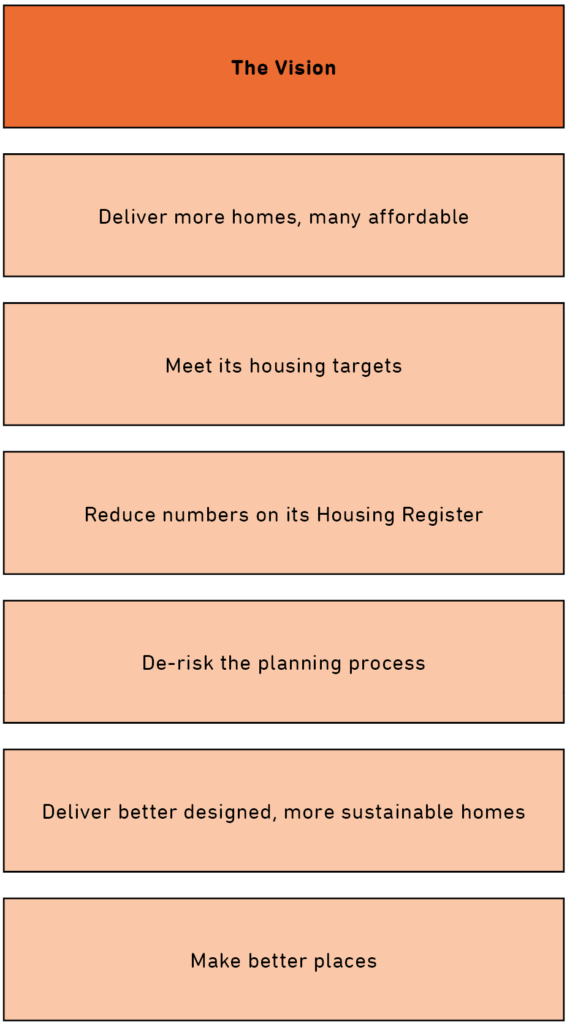3. Why Build on Small Sites?
3.1 Why encourage the delivery of small sites?
Lewisham needs to deliver more new homes, especially affordable homes. In June 2020, 9,000 households were on the housing register. Of these, 2,500 were in temporary accommodation. It is calculated that the borough needs to build 1,667 homes every year for the next ten years with at least 23% of these being provided by small sites of less than 0.25 hectare.
Small site development is required because:
- Government planning policy recognises the contribution of small sites to housing delivery as important, and suggests they should provide 10% of an area’s housing requirement
- The 2021 London Plan mandates boroughs to meet certain housing targets with small sites playing an essential part. Lewisham’s ten-year target is 3,790 new homes on small sites
Lewisham’s small sites strategy aims to:
- Deliver more homes, including those that are genuinely affordable
- Diversify who is delivering Lewisham’s housing supply to make it more resilient
- Encourage local builders and developers, thus stimulating the local economy and providing jobs
- Increase density, helping to support local centres and infrastructure
The following pages set out the vision and key objectives underlying this small sites strategy.

sites housing

Improve the quality of new homes
Encourage applicants to build homes which are sustainable, resilient, healthy to live in and of exemplary design. Ensure they respond appropriately to the character and heritage of their neighbourhood.
Increase Lewisham’s supply of new homes
Develop a strategic approach to small site intensification which de-risks the planning process and results in more sites coming forward.
Identify sites and areas for intensification
Promote small sites and identify priority areas for intensification, to help create better places for both new and existing residents, by enabling more commerce, services and public transport to develop.
Reduce risk
Provide clear principles for the development and intensification of small sites, minimising planning risk, optimising site capacities and supporting Lewisham’s emerging spatial strategy
for significant growth in suburban locations.
Learn from elsewhere
Similar studies by other London councils and guidance from the GLA can provide leads. However, Lewisham’s approach needs to be specific to its own culture and development needs so as to enthuse residents and ward councillors with a vision they can support.
Engage with local stakeholders
These include housing associations, private developers, local contractors, architects, landowners, community groups, neighbourhood forums and amenity societies, whose experiences can help shape the strategy and guidance.
Optimise the supply of affordable homes
Establish clear guidance to reduce the risks associated with small site planning applications, encouraging developers of affordable housing to bring forward new affordable housing, and to enable individuals to reduce the cost of delivering new homes.
Make advice accessible and easy to understand
Provide printed and online advice which is user-friendly and accessible. Avoid jargon, and help applicants successfully navigate the planning policy maze. Aim to widen participation so more people can build.
3.1. Policy Context
This Small Sites Development Strategy document, and its associated Supplementary Planning Document (SPD) provides guidance to applicants considering small sites housing development in Lewisham.
A tiered layering of policy documents provides the planning policy context for the Small Sites SPD. The most significant of these are:
- The NPPF
- The 2021 London Plan
- Lewisham’s Local Plan
3.2. NPPF
The National Planning Policy Framework (NPPF) promotes sustainable development and encourages local planning authorities to plan positively for new development and to approve proposals wherever possible. It aims for a genuinely plan-led system to enable local people to shape their surroundings and seek high standards of design.
The NPPF identifies small and medium sized sites as able to contribute to housing need. It calls on local planning authorities to identify these sites to accommodate at least 10% of their housing requirement, and support the development of small sites. Nonetheless, they should resist inappropriate development of residential gardens where this would cause harm.
To provide maximum clarity and to encourage good design the NPPF encourages definitive plans, supplementary planning documents, and visual tools such as design guides and codes.
3.3. London Plan
The 2021 London Plan establishes increasing the rate of housing delivery from small sites as a strategic priority. It sets out a ‘small sites’ housing target for every borough as part of its Policy H2.
For Lewisham, this small sites target for the ten-year period from 2019/20 is 3,790 net housing units, and makes up roughly 23% of the borough’s overall London Plan housing target.
It foresees incremental intensification within 800 metres of transport hubs or town centres and recognizes that local character will need to change over time in appropriate locations to achieve this.
The Plan hopes to revive the role of small and medium sized developers, diversify the locations for development, encourage custom-build and community-led housing, support town centre economies and promote modern methods of construction.
It recommends that boroughs should provide design guidance in the form of design codes to provide clarity for potential applicants and reduce planning risk.
The Plan expects small sites development to contribute to affordable housing delivery, either on-site or, more often, as cash in lieu contributions.
3.4. Local Plan
Lewisham’s 2014 adopted Local Plan is in the process of being superseded by the emerging Local Plan which states Lewisham’s aim as not just to meet the London Plan small sites target, but to exceed it.
It recognises that small sites provide opportunities to deliver new affordable homes, and can play an important role in addressing local deprivation. For instance, the designated Areas for Regeneration in the south of the borough – that is Whitefoot, Downham and Bellingham wards – have distinctive characters and urban grain based on historic estate development with a lack of large site opportunities. Small site development here could provide a mechanism for more incremental investment and area improvement and help to address the underlying causes of deprivation.
The Local Plan will provide the planning policy context for the Small Sites SPD. When determining applications, the Lewisham Local Plan and its policies, along with relevant guidance – including the Small Sites SPD – will be used to reach a balanced decision. Development proposals will be expected to have regard to this planning guidance and show how it informs the development through a design-led approach.
The draft Local Plan contains a number of items relevant to small sites, and section HO2 Optimising the use of small housing sites addresses them specifically. Relevant points include:
- The Council will safeguard employment sites where possible
- There is no mention of habitable room separation distances, previously set at 21m
- A potential infill site should have a street frontage
- Demand for parking must be considered
- Development must not overshadow neighbouring back gardens
- Backland development must provide easy access and avoid gates
- Generally, the use of garden land for development is to be avoided and will be strongly resisted
- Small sites should contribute towards affordable housing targets, respond positively to local character, enhance biodiversity, protect local amenity, and be designed to a high quality
- Incremental intensification may lead to an area’s character evolving over time, and this is not necessarily unwelcome